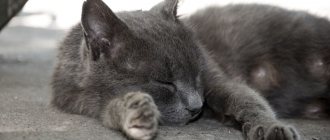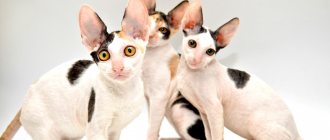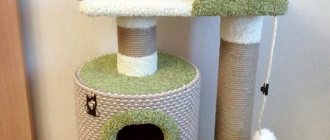Cats use their paws to groom themselves (especially to clean the most difficult parts, reaching the ears, neck, face and chin), but their paws are also used for jumping and for communicating with other animals because they release pheromones. That's not all. Cats sweat through their paws because they contain sweat glands. This cooling system is very useful to prevent your cat from overheating, especially in summer.
If you notice that your cat has hot paws, this is most likely a sign of a fever, in which case you should observe his behavior to determine the severity of the situation.
Is the cat or cat hot?! Reasons for rising temperature
The normal body temperature of a cat is 38-39.5°C. For a person, this temperature indicator is on the verge of critical. Therefore, touching a cat and feeling that the cat is hot
, the owners begin to panic.
Don’t get nervous right away; first, measure your pet’s temperature - this means that the cat is hot
, but for him the temperature is within the normal range.
Also the cat just has a hot nose
, in the absence of any other symptoms, is by no means an indicator of ill health.
The cat has just woken up; in a few minutes the temperature balance will be restored. The animal is scared or nervous; stress is a common reason why a cat is hot.
The heat caused by these reasons, after a short time,
the cat's hot nose
will return to normal temperature.
Symptoms of fever in cats and kittens
But if the thermometer shows over 39.5°C, and the cat has hot ears and a dry nose,
There are reasons for concern, especially if you have symptoms such as:
- the cat refuses food and water;
- general lethargy, drowsiness;
- the cat's ears are hot
, red, swollen, with an unpleasant odor; - hides from the light, from hands, behaves inappropriately;
- the cat's nose is hot and dry
, with dried purulent crusts; - signs of a cold (sneezing, coughing, runny nose, eyes).
Explanation why the cat is hot,
in this case, there can be one thing - there is an inflammatory process in the body.
If the cat has a hot nose and ears
with swelling, redness, dark plaque in the ears with an unpleasant odor - infection with ear mites can be assumed.
Otitis, which accompanies this parasitic disease, explains why the cat has hot ears
- the inflammatory process in them will not necessarily raise the general temperature. The increase in temperature can also be local, directly in the areas of inflammation.
The cat has hot ears
There are also other reasons:
- head and ear trauma,
- infectious or viral disease;
- urinary tract infection, intestinal disorder, etc.
How to help an animal
Hot ears in a cat are not a pathology in themselves, which means that trying to cool only one ear (for example, by applying ice compresses) is pointless. The first thing to do is to examine the animal for other symptoms. If they are not there, then you should leave the cat alone for 20–30 minutes and feel the ears again - in a healthy animal, by this time the blood flow will normalize and the skin will no longer be hot.
When fiery ears are still a symptom of some kind of disease, it is necessary to begin treatment. It depends on the diagnosis:
- If the ears are burning due to severe stress, then first you need to create the most comfortable conditions for the cat and remove all irritants. There is no need to forcefully try to pick up the animal or stroke it (this will only increase the stress). It is better to provide maximum peace, but leave water and tasty food nearby. If after a couple of days the cat’s mental well-being is not restored, veterinarians will prescribe sedatives:
- Clomipramine;
- Cat Baiyun;
Kot Bayun is a sedative medicine based on natural herbal ingredients
Amitrazine is a veterinary drug that is used for cats in the treatment of pathologies caused by sarcoptic mites
During treatment of otitis media, ear mite infection, and after surgery, the cat must be wearing a medical collar that prevents the animal from scratching the sore ear.
If the cat has a fever
If the ears are hot, you need to make sure that the animal’s body temperature is normal. If you don’t have a thermometer, just feel the animal’s nose - it should be cold and wet when awake. If you have a temperature measuring tool at home, you should use it. For an adult cat, readings below 37.5˚C and above 40˚C are a serious reason to immediately contact a veterinarian. Fever occurs when:
- infectious diseases;
- poisoning;
- tumors;
- allergies.
Video: how to correctly measure a cat's temperature
Sometimes an emergency situation arises when it is impossible to quickly get an appointment with a specialist. Inaction during hyperthermia is dangerous, therefore the following measures are allowed to eliminate fever:
- Cover the animal for a couple of minutes with a towel soaked in cold water (do not put the cat in an ice bath, as this can cause heart attacks).
- Give the cat echinacea tincture at the rate of 1 drop per 1 kg of animal weight (dilute the drug with water in a ratio of 1:5).
- Place the antipyretic suppository Cefekon (50 mg for an adult cat, 25 mg for a kitten).
Remember, fever is a dangerous symptom. Even if you manage to knock it down, it is very important to take your cat to the vet as soon as possible. He will conduct an examination and find out the exact cause of the fever, which will help prescribe the correct treatment.
Many cat owners panic if their pets' ears become hot. But, according to experts, flaming ears themselves are not a reason to suspect a disease. You need to worry if the animal's general body temperature rises, it itches constantly, refuses to eat, and sleeps poorly. Such symptoms are already a reason to visit a veterinarian, find out the reason for the cat’s poor health and immediately begin treatment.
What to do if the cat or kitten is hot?!
All of the above applies to kittens, but due to the development of the body, all sores are much more severe. The baby's immunity is fragile due to hormonal changes. So if the kitten is hot, the kitten has a hot nose
, and when measuring the temperature you see frightening numbers on the thermometer, you can’t hesitate, the baby needs to be shown to the doctor.
Excessively hot paws on a kitten
also indicate an elevated temperature.
So, you discovered that the cat has a hot
nose,
you noted an elevated temperature -
what to do
next?
The animal should be shown to a specialist as soon as possible.
In order not to drag a sick cat to the clinic, the best option is to call a veterinarian at home. The veterinarian comes to your home with all the necessary tools and medications to provide the necessary veterinary care.
Source
Characteristics of cat paws
Cats' feet are very special, they have retractable claws and walk using the pads of their feet. Thanks to this, the cat moves quickly and silently over any terrain.
The pads are made up of many elastic fibers and dense fatty tissue, but their main characteristic is that cats sweat through them. Sometimes sweating increases when your cat is exposed to stressful situations, such as if you have to take him to the vet.
© shutterstock
Another feature of cats is that the sweat glands of the pads secrete a fragrant oil that carries pheromones. The scent is unique to each cat and is used to mark its territory. With each step, the cat delineates its space and establishes its domain.
When your cat marks a piece of furniture, wood or any other surface with her claws, she leaves her exclusive signature and tells her peers that this is her home.
What body temperature is considered normal for a kitten and an adult cat?
A cat's body temperature depends on many factors:
- age – in kittens it is higher than in adult animals;
- state of wakefulness or sleep - in sleeping mammals all life processes are slowed down and body temperature is reduced;
- volume of food eaten - in cats, when overeating, this indicator usually increases;
- level of physical activity - during active pastime, the body temperature of cats rises;
- state of mind - when a cat is nervous or experiences strong emotional stress, it becomes hot;
- Ambient air temperature - the higher it is, the hotter the animal’s body.
This is not a constant value. During the day, this parameter usually changes. Normally, they can deviate from the standard values by no more than 0.5°C up or down. Information on the acceptable values of this indicator for healthy representatives of the cat family is presented in the table:
| Age and physiological state of cats | Normal values, degrees | |
| Bottom line | Upper limit | |
| Newborn kittens | 40 | 40,5 |
| Grown up cubs | 38,5 | 39,5 |
| An adult animal in a state of wakefulness | 38 | 39 |
| Prenatal period | 37 | 39 |
Why did my cat's ears become hot and red?
The condition of the ears, as well as the nose and eyes, can say a lot about the well-being and health of your four-legged pet. If your pet's ears turn red and become hot, this symptom should not be ignored. Inaction can lead to unforeseen consequences.
The causes of redness and increased temperature of the cat's ears and head are conventionally divided into physiological and pathological. The former do not pose a threat to the health and life of the pet and do not require any special measures to be taken, the latter indicate internal problems and require human intervention.
Physiological causes of increased ear temperature
Normally, a cat's ears should be warm. If they become hot, it means the pet:
- I got nervous. These are very impressionable and vulnerable animals. Anything can shake their peace of mind: a change of place of residence, a visit to a veterinary clinic, a car trip, the appearance of a new four-legged family member or child in the house, screams and quarrels in the house. Usually the cat's calmness is gradually restored on its own. However, sometimes, to overcome severe stress, a pet needs sedatives.
- Spent time actively. After jogging and vigorous play, cats' body temperature rises and, as a result, their ears become hot.
- I lay in direct sunlight for a long time. In this case, it is important to understand when your pet’s ears simply become warm and red under the scorching sun, and when he received heatstroke. The negative consequences of a cat's prolonged exposure to the sun are accompanied by symptoms such as increased heart rate (over 140 beats per minute), redness of the mucous membranes, disruption of the integrity of the blood vessels under the eyelids, and breathing problems.
- He warmed himself by the heating devices.
- I was in a room that was too hot for a long time.
- I recently woke up. As with the nose, the condition of a cat’s ears changes during sleep—they become warmer than usual.
- I slept with my ear pressed to the floor, as a result of which it became hotter than usual.
This condition is often observed in pregnant pets. This is normal. Usually, after the birth of the cubs, this problem disappears on its own.
Pathological causes (infectious disease, otitis media, otodectosis)
An increase in your pet's ear temperature may be a sign of the following diseases:
- Infectious pathology.
- Ear infection. In this case, it is usually the animal’s inflamed ear that is hot. However, the inflammatory process can affect both hearing organs.
- Ear scabies (otodectosis).
Otodectosis
The causative agents of otodectosis in representatives of the cat family are microscopic mites of the genus otodectos cynotis, which parasitize the auricle and external auditory canal. A dry or moist substance of dark brown, even black color accumulates in the diseased organ, the animal becomes restless, constantly shakes its head, scratches its ears with its paw, and rubs them against protruding objects to relieve the incessant itching.
There may be other pathological causes for this problem. Your four-legged pet's ears may turn red and become hot due to:
What accompanying symptoms should you contact a veterinarian for?
Contacting a veterinary clinic is required if the following accompanying symptoms are present:
- nausea and vomiting;
- disruption of the bowel movement process in the form of constipation or diarrhea;
- partial or complete loss of interest in food;
- changes in behavior: lethargy, apathy, decreased motor activity, lack of response to external stimuli;
- sleep problems;
- signs of damage to the hearing organs by ear mites;
- increased temperature of the whole body;
- wet or dry cough;
- dry and too hot nose (normally it is a little wet and cool);
- difficulty urinating;
- blood in urine;
- hair loss;
- peeling of the skin;
- increased salivation.
If you identify these signs, you should not try to help your four-legged pet on your own. At home, it is impossible to determine the cause of their appearance, and inept actions when trying to eliminate pathological symptoms can lead to tragic consequences.
Source
How does the condition manifest?
In cats, periods of increased activity are usually followed by apathy and drowsiness. It is difficult for owners to understand why and at what exact moments this happens. Therefore, a situation where a cat is lethargic, hardly eats and sleeps a lot, is alarming.
Read also: How to tie a scarf on a man
The owner should clearly know that poor appetite and less active behavior do not always indicate an illness in the animal. And the veterinarian is sometimes unable to understand why the cat is lethargic. The observations of an attentive and loving owner are extremely important here.
The main signs of cat health, in addition to good appetite and good spirits, are:
- shiny and smooth coat;
- pink and slightly moistened mucous membranes;
- cold and slightly damp nose (normally, during sleep it can become warm and dry);
- pulse, respiratory rate and temperature are within normal limits;
- absence of excessive discharge from the eyes, ears and nose, plaque in the mouth, salivation and unpleasant odor from the mouth and ears.
Normal body temperature for cats
The body of a cat, like a person, has its own temperature for optimal existence. The central nervous system, hypothalamus, pituitary gland, and other internal mechanisms that are still not fully understood are responsible for maintaining it at the proper level, natural heat exchange.
The normal temperature for a cat is considered to be 37.5-39.3C. Moreover, this indicator is individual for each cat.
A cat's body temperature may depend on:
- age;
- breeds;
- individual characteristics of the body;
- body weight;
- ambient temperature;
- season of the year;
- Times of Day;
- intensity of metabolic processes.
What to do?
If you suspect your cat is unwell, first of all, you need to measure its temperature. It should be kept in mind that the normal temperature for an adult cat is 38-39 degrees. In small kittens, the normal temperature can be up to 40 degrees. And, for example, in hairless cats it is even higher – 41.5.
What to do if hot ears are still a sign of disease? The answer is clear: immediately contact a specialist who will examine the cat and prescribe appropriate treatment.
Thus, we can say with confidence that a cat’s hot ears are not yet a reason to sound the alarm. High ear temperature in itself is not a sign of disease. If your pet not only has hot ears, but also a dry and hot nose, and behavior and appetite have also changed, then in this case we can talk about the onset of the disease.
When to take a cat's temperature
Having an idea of what the normal temperature of a cat is, owners will be able to determine the health status of their pet. In case of severe deviations in physiological parameters, if the temperature is increased/lowered, it is very important to take appropriate measures in a timely manner. Therefore, furry pet breeders should know how to correctly measure body temperature.
© shutterstock
To measure temperature in animals it is necessary:
- If there are signs of poisoning or intoxication. Manifested by nausea, vomiting, refusal to feed, diarrhea, depression.
- If the cat constantly lies down, refuses to participate in outdoor games, and reacts inadequately to external stimuli.
- The cat has a dry, hot nose and ears.
- Mucous, catarrhal, purulent discharges appeared from the eyes and nose.
- With a sharp decrease, lack of appetite, increased thirst, if the cat refuses his favorite treats.
- Mucus, blood clots, inclusions, and flakes are noticeable in the stool.
- The cat is sneezing, coughing, and has shortness of breath.
- The animal has a chill, the fluffy is looking for a warm, secluded place.
- If a cat suddenly loses weight, the mucous membranes are anemic, pale, and bluish.
Timely monitoring of the cat’s body temperature will allow timely detection of any abnormalities in the animal’s body. Based on the indicators, the veterinarian will be able to make the correct diagnosis and prescribe adequate and effective treatment.
How to measure a cat's temperature correctly
Taking into account the individual characteristics of the body, in order to know what body temperature should be normal for a healthy cat, owners should take measurements in the morning and evening throughout the week. Write down the indicators in a notepad.
The procedure for measuring temperature is quite difficult and unpleasant for pets. It is carried out rectally. To measure indicators, purchase a mercury, electronic rectal thermometer from a veterinary pharmacy.
Advice! It is best to carry out the measurement procedure with an assistant. It is very important that the cat is securely restrained.
Sequencing:
- Lubricate the tip of the measuring device with Vaseline and baby cream. This will make it easier to insert into the rectum.
- Secure the animal on its side on a flat, hard surface. To prevent your cat from scratching you, you can swaddle it in a diaper or towel. It is permissible to measure the animal's temperature in a standing position.
- Hold your head by the scruff of the neck to prevent the cat from biting you. Move your tail to the side or lift it high. Make sure the cat doesn't escape. Talk to the animal in a gentle tone.
- Carefully insert the thermometer into the anus to a depth of two centimeters.
- After three minutes, you can evaluate the results obtained.
Hyperthermia in cats
The mechanism for increasing the temperature of the animal body is based on an imbalance between the process of heat generation (heat production) and heat transfer. The balance can be disturbed under the influence of unfavorable ecto and endofactors of various natures.
An elevated body temperature in a cat can be caused by:
In small kittens, an increase in temperature by one or two degrees above normal can signal the presence of endoparasites and the development of helminthic infestation.
Important! Elevated temperature in infectious and viral diseases is a physiological protective-adaptive reaction. If a cat suffers from diseases of non-infectious etiology, temperature readings may also be elevated.
Symptoms of hyperthermia:
- lethargy, apathy, drowsiness;
- rapid breathing, shortness of breath;
- disruption of digestive processes;
- increased thirst;
- rapid pulse, palpitations, high blood pressure;
- convulsions, muscle spasms, fever.
The cat refuses food and favorite treats and is in a depressed state. Possible severe vomiting and diarrhea.
© shutterstock
Emotional overload, vaccination, taking certain medications, intense physical activity can also lead to a short-term increase in the general temperature of cats. A cat is an animal with a subtle psychological organization, so protect your pets from stress.
If the pet’s condition is normal, the cat is active, feels well, there are no obvious clinical symptoms or signs of malaise, but the temperature is elevated, take a second measurement after a while.
Reduced body temperature in cats
If a pet's temperature is below 37C, this condition indicates problems in the animal's body.
Causes of hypothermia:
- depression, drowsiness, apathy;
- chills, muscle tremors;
- anemia of the mucous membranes;
- viral, bacterial diseases characterized by immunosuppression;
- malignant neoplasms;
- pathologies of the cardiovascular and nervous systems;
- chronic renal, liver failure;
- hypothermia of the body;
- bleeding.
If the temperature is low, the cat will look for secluded, warm places. The cat becomes inactive and depressed . The cat reacts reluctantly to external stimuli; slight trembling is noticeable. With a significant decrease in physiological temperature indicators (up to 36 degrees), metabolic processes and heart rate slow down, and blood pressure decreases. Breathing becomes rare and shallow. The cat is breathing heavily and wheezing can be heard. In veterinary medicine, such a condition is characterized as shock, so it is very important to provide assistance to your pet as quickly as possible.
What should a healthy cat's nose look like?
A cat's nose is a sensitive tool for exploring its environment. With its help, a pet can perfectly identify odors, because the sense of smell of these animals is 14 times superior to that of a human. The number of receptors in its olfactory organ can reach 80,000,000 (5,000,000 in humans). True, this system includes not only the nose, but also a special Jacobson tube located on the palate (which is why you can sometimes notice that the cat draws air into its mouth).
In addition, the nasal cavity has another function: warming and cleaning inhaled air from dust, germs and bacteria.
The nose, called a speculum, helps to set the temperature of an object even without touching it. When a pet sniffs the food offered for a long time, it determines not only its smell, but also how hot it is. A mirror can tell a lot about possible disturbances in the functioning of an animal’s body.
In a healthy cat, in a calm state, the nose is slightly cool, moist, slightly shiny, and has no scales or crusts.
The speculum becomes moist because the secretion of the mucous membranes is released. It retains molecules of foreign substances to accurately detect odor and creates a protective film from exposure to adverse factors. In addition, the cat constantly licks its nose, which additionally moisturizes it.
The nose (mirror) should be free of dirt and crusts
But if you feel that your pet’s nose is dry and hot, there is no cause for concern yet.











